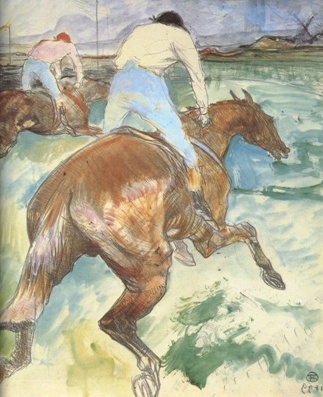and so begins the race to paid parental leave for lady jockeys
The Australia Jockeys Association is lobbying for changes to rules governing parental leave after it was revealed female jockeys are missing out due to indirect discrimination in federal policy. To be eligible for paid parental leave under the still incumbent Labor scheme, applicants must have worked 10 months out of 13 before the child was born. Women jockeys can only accumulate seven months of the minimum 10 required to secure leave unless they search elsewhere for work due to Australian racing rules.
The 2010 Australian Rules of Racing ban pregnant jockeys to as much as sit on a horse as part of their employment after their first trimester. Furthermore, pregnant jockeys must report their pregnancy and provide adequate medical opinion that they’ll be safe as a means to continue duties into their first trimester.
Contemporary medical thought on riding is that it’s fine and dandy in the first trimester. But biological changes in weight, softening ligaments and tendons and a change in sense of gravity make it apparently easier to fall off the further along a woman is. Plus, the repositioning of the foetus away from the pelvic girdle at 12 weeks means there’s no cage of bone to protect the foetus from any impact anymore.
But social barriers can also be seen as having a role in forming such rules and opposition to women riding horses during pregnancy aren’t new. Historically, riding has been viewed as a huge risk to the child, particularly in nobility where heirs and such are concerned. Such thought has continued and often translates into criticisms of women who do choose to carry on riding after the window period of three months, including Queen Elizabeth II’s granddaughter Zara Phillips, despite her personal comfort in doing so. As such the Australian Rules of Racing’s paternalistic policy maintains such ideas about women’s bodies, but perhaps not without cause.
The risks of horse riding are inherently higher for pregnant jockeys. The sport was found to be the most dangerous job on land in a 2009 Medical Journal of Australia study, coming second only to offshore fishing. US researchers found for every 1,000 jockeys racing over the period of 1993 to 1996, more than 600 sustained injuries requiring medical attention and most often racing accidents would see multiple parts of the body requiring treatment. Of course, for anyone who has been to the races, one cannot discount the visual cue of an ambulance chasing competitors during a race as a reminder of the risks jockeys take.
For these reasons it seems plausible then that the rules keep pregnant jockeys off the track. All employers have a duty of care to reduce the risk of injury or death to employees of sexes, let alone mother and foetus. Of course, not allowing pregnant jockeys to race helps save an employer from being sued if the worst should happen.
Consequently, the Australian Jockey Association is moving to have a change in parental leave policy as opposed to changing pregnancy clauses in its rules as the Liberal government is yet to implement its own scheme – which it is aiming to have in place by June 2014.
But it begs the question: why it has taken so long since the Labor parental leave scheme was legislated almost three years ago to get in there and fight for the rights of its female members? This is particularly the case as Liberal policy will still incorporate Labor’s eligibility test of mothers working for 10 of the 13 months before the child is born.
Undoubtedly there have been a lot of barriers in place for female jockeys over the years, with cruddy conditions such as co-ed (i.e. male) changing rooms and other signs of a masculine culture (including not being fed at racing meets) are all but extinct in the industry.
With 25% of jockeys and 48% of apprentices possessing lady parts, the AJA and racing industry has finally acknowledged it needs its female members to survive and thrive. As a result, it must ensure that women’s careers aren’t hindered as they have filled quite a void as more and more men depart from the track. They might be off to a slow start, but the AJA is off!


